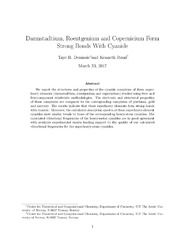| dc.contributor.author | Demissie, Taye Beyene | |
| dc.contributor.author | Ruud, Kenneth | |
| dc.date.accessioned | 2018-09-03T10:46:31Z | |
| dc.date.available | 2018-09-03T10:46:31Z | |
| dc.date.issued | 2017-05-05 | |
| dc.description.abstract | We report the structures and properties of the cyanide complexes of three superheavy elements (darmstadtium, roentgenium, and copernicium) studied using two‐ and four‐component relativistic methodologies. The electronic and structural properties of these complexes are compared to the corresponding complexes of platinum, gold, and mercury. The results indicate that these superheavy elements form strong bonds with cyanide. Moreover, the calculated absorption spectra of these superheavy‐element cyanides show similar trends to those of the corresponding heavy‐atom cyanides. The calculated vibrational frequencies of the heavy‐metal cyanides are in good agreement with available experimental results lending support to the quality of our calculated vibrational frequencies for the superheavy‐atom cyanides. | en_US |
| dc.description.sponsorship | The Norwegian Supercomputing program NOTUR | en_US |
| dc.description | This is the peer reviewed version of the following article: Demissie, T.B. & Ruud, K. (2018). Darmstadtium, roentgenium, and copernicium form strong bonds with cyanide. <i>International Journal of Quantum Chemistry</i>, 118(1). https://doi.org/10.1002/qua.25393, which has been published in final form at <a href=https://doi.org/10.1002/qua.25393> https://doi.org/10.1002/qua.25393</a>. This article may be used for non-commercial purposes in accordance with Wiley Terms and Conditions for Use of Self-Archived Versions. | en_US |
| dc.identifier.citation | Demissie, T.B. & Ruud, K. (2018). Darmstadtium, roentgenium, and copernicium form strong bonds with cyanide. International Journal of Quantum Chemistry, 118(1). https://doi.org/10.1002/qua.25393 | en_US |
| dc.identifier.cristinID | FRIDAID 1606042 | |
| dc.identifier.doi | 10.1002/qua.25393 | |
| dc.identifier.issn | 0020-7608 | |
| dc.identifier.issn | 1097-461X | |
| dc.identifier.uri | https://hdl.handle.net/10037/13632 | |
| dc.language.iso | eng | en_US |
| dc.publisher | Wiley | en_US |
| dc.relation.journal | International Journal of Quantum Chemistry | |
| dc.relation.projectID | info:eu-repo/grantAgreement/RCN/SFF/179568/Norway/Centre for Theoretical and Computational Chemistry/CTCC/ | en_US |
| dc.relation.uri | https://onlinelibrary.wiley.com/doi/pdf/10.1002/qua.25393 | |
| dc.rights.accessRights | openAccess | en_US |
| dc.subject | VDP::Matematikk og Naturvitenskap: 400::Kjemi: 440 | en_US |
| dc.subject | VDP::Mathematics and natural science: 400::Chemistry: 440 | en_US |
| dc.subject | copernicium | en_US |
| dc.subject | darmstadtium | en_US |
| dc.subject | relativistic | en_US |
| dc.subject | DFT | en_US |
| dc.subject | roentgenium | en_US |
| dc.subject | superheavy elements | en_US |
| dc.title | Darmstadtium, roentgenium, and copernicium form strong bonds with cyanide | en_US |
| dc.type | Journal article | en_US |
| dc.type | Tidsskriftartikkel | en_US |
| dc.type | Peer reviewed | en_US |


 English
English norsk
norsk